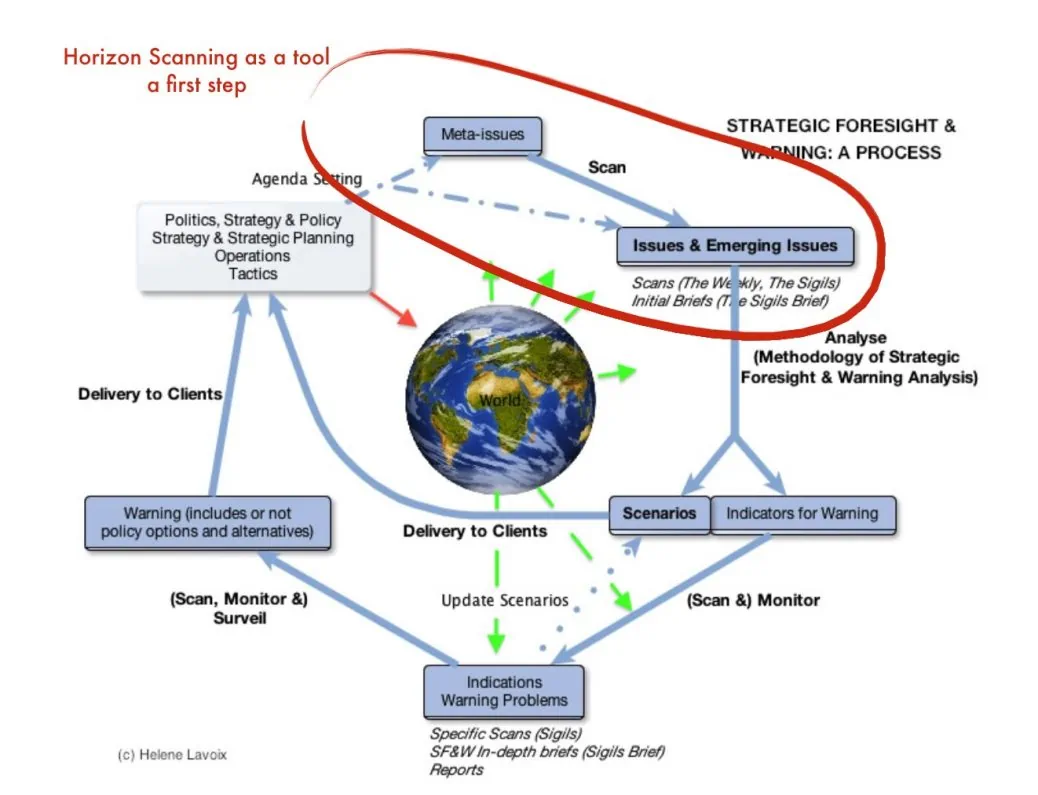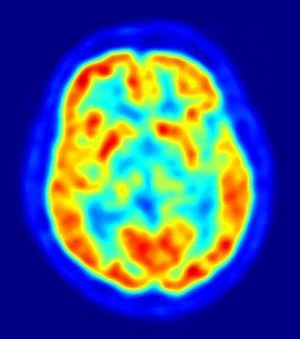(重写和修订版) 地平线扫描和预警监测是用于预见未来、预测不确定性和管理风险的一系列活动的一部分。它们的实践对于成功的战略预见和预警、风险管理、未来主义或任何预见性活动都至关重要。
监测是一个通用术语,用于许多活动,而地平线扫描则非常具体,主要用于预见性。地平线扫描是一个在21世纪初出现的术语。它既指战略展望过程中的一个具体工具,也指整个展望过程。(Habbeger, 2009).*
在此,我们将重点讨论地平线scanning,作为整个战略预见过程中的一个具体工具。我们将把它与预警监测(以下简称监测)进行对比。首先,我们将提出这两个概念的定义。然后,通过对这两种活动的实践进行比较,我们将强调两者之间的相似性和差异。同时,我们将确定最佳做法。最后,我们将得出结论,地平线scanning,作为一种工具,实际上是任何-好的-监测预测的第一步。
地平线扫描和监测的定义
地平线扫描
作为一种工具,地平线扫描允许识别潜在的新主题或元问题和议题,回答我们议程或背景中所定义的关切。然后,我们将需要深入分析由此确定的问题。
因此,地平线扫描宁寻找表明新的元问题和问题出现的微弱信号。因此,扫描必须对所关注的核心问题采取尽可能大的范围。
地平线scanning的想法是建立在较早的想法和方法之上的,如 "环境scanning"、"战略预见 "和 "指示和警告"(也被称为 "战略警告 "和 "警告情报",见下文)。 格拉博, 2004).实际上,正如Glenn和Gordon所强调的,在1960-1970年代,大多数未来学家使用了"'环境扫描'这个术语。然而,随着环境运动的发展,一些人认为这个词可能只指监测自然环境因人类行为而发生变化的系统。 为了避免这种混淆,未来学家创造了各种标签,如 "未来扫描系统"、"早期预警系统 "和 "未来情报系统"。军方则使用 "战略预警 "和相关术语。其目的是为了避免战略上的意外(如珍珠港)。
英文 "地平线扫描"与法文""不一样。veille"与一些作者的断言相反--例如尼古拉-卡雷斯特("地平线扫描" 2012年和 pdf).我们可以把""翻译成最好的。维耶尔"由 "监测"--泛指,而不是像这里一样更具体地用于警告。我们也可以把它翻译成 "情报收集"。
Charest,实际上,指的是一个过程。"一个收集、分析和传播增值信息以支持决策的有组织的正式过程"。然而,这是一个没有未来和预测的过程。奇怪的是,作者自己也强调,地平线scanning的英文含义意味着预见性、预期性。
与其将 "veille "和地平线扫描这两种做法和两个词混为一谈,不如将两者区分开来。事实上,尽管这两种活动密切相关,但其中一种,即地平线scan宁,必须处理未来的问题,而另一种则不必面对这一挑战。
正是这种预期性,即用Grabo的话说,"对未来作出判断 "的必要性(同上),产生了这两种相关活动之间的本质区别。
在各种政府办公室的名称中使用 "地平线扫描",有助于普及这一名称。例如,我们有英国 地平线扫描中心。 2004 年,在呼吁在整个政府中发展这样的卓越中心之后,创建了 "新加坡卓越中心" (Habbeger, 2009, p.14),或者新加坡的 风险评估和地平线扫描(RAHS)计划在2005年推出(Lavoix, 2010).这种想法成为时尚的方式也促成了围绕其含义的混乱。
监测预警
监测是战略预警过程的一部分。关于情报、预警和战略突袭的文献很好地记录了这个想法和过程。事实上,至少从二战开始,各行为体就开始使用战略预警,而情报研究现在已经成为一个成熟的知识体系和一门学科。对于进一步的阅读,有一个很好的关于情报相关事项的参考书目。 J.Ransom Clark的《情报学文献目录》。,特别是 关于战略预警的部分.
监测问题将允许识别警告问题。然后,我们将使用适当的模型和相关指标来监测这些问题。作为提醒,一个指标是一个概念,是对某一事物的抽象化。迹象是在特定情况下与该指标相对应的现实。因此,我们使用指标来收集指示。例如,国内生产总值(GDP)的增长是一个指标,5%是一个特定国家和时间的指示。速度可以是一个指标,60公里/小时是特定时间特定设备在特定地点的指示。
监测和监督都会引导收集必要的信息,如模型和相关指标所定义的。
作为提醒,在整个SF&W的过程中,我们的重点不断缩小,所用的词汇也反映了这一点。我们从最笼统的、包含的内容转向最详细的内容。让我们举个例子,能源是一个 "元问题"。那么,"问题 "可以是 "石油安全"、"石油峰值"、"铀峰值"、"石油价格的波动"、"欧洲和俄罗斯之间的能源政治"、"中国的能源 "等等。"问题 "可以是更具体的 "Gasprom政策","Keystone管道","一带一路倡议中的能源",或 "巴基斯坦的能源和一带一路倡议",甚至是 "围绕这个或那个工厂的紧张局势",等等。
地平线1TP9预警和监测实践中的警告
如果定义不同,那么我们一方面做地平线扫描,另一方面做监测预警的方式是否真的有区别?扫描是否包括在预警监测中?我们是否应该在扫描和监测中使用同样的程序和同样的工具?或者我们必须使用不同的方法?
同样以模型为基础,但模型的复杂程度不同
地平线扫描宁和监测之间的第一个区别是两者在整个SF&W过程中的位置。扫描是指 第一步的分析.这意味着什么呢?

由于这是你在处理一个问题时做的第一件事,那么扫描地平线就隐含地假定对这个问题没有理解或很少理解。然而,实际上这只是一个表象。
试着在心理上做练习:如果你开始寻找什么,即使是以最宽松的方式,要做到这一点,你需要对你正在寻找的东西有一个想法,即使是最小的想法。发生的情况是,在无意识中,你依赖一个认知模型。这个认知模型是隐性的。因此,为了scan的地平线,你已经使用了一个模型,即使它是一个非常不完美的模型。
在展望或风险分析的过程中,你要进一步监测一个问题。这是为了在分析过程结束时进行,因此一旦你非常了解你的主题。在上图中,监测是在我们创建了情景并确定了警告指标之后进行的。
因此,监测也是建立在一个模型之上的。然而,我们已经把这个模式明确化。我们通过分析过程改进和完善了它。
因此,从根本上说,地平线扫描和监测是相似的。它们的区别实际上在于所使用的模型的复杂性,而不在于进行扫描或监测的第一步所使用的实际过程。因此,扫描和监测可以利用最常见的相同的工具或支持。
广阔的前景,包罗万象的产出
第二,scan的定义表明,它应该只识别弱信号。然而,事先根据信号的强度来选择信号--假设这是可能的--将产生反作用,在某些情况下是不可能的。事实上,一个问题的强信号有时也可能是其他问题出现的弱信号。
因此,在通过旨在识别新出现的元问题和问题的scan收集信号时,最好是尽可能地广泛和包容。
在实践中,你可以注意到新的信号,并松散地开始将它们与其他元问题或问题联系起来。
同样,对一个问题的监测和对一个问题的监视也可能发现新出现的问题的信号。同样,你应该确保记录这些发现。
因此,对于地平线扫描和监测来说,你需要有一个尽可能开放和广泛的认知构成,同时,也要能够将这个或那个事实、趋势或 "事情 "与这个问题、那个问题和这个指标准确地联系起来。
地平线扫描的信号及其强度,监测的指示和时间表
最后但同样重要的是,由于各种偏见,无论是分析师还是客户,决策者和政策制定者往往无法看到、识别和考虑一些 "地平线以下 "的信号。只有当这些信号在 "地平线以上 "时,他们才能够接受这些信号,这意味着这些信号要强得多,例如 关于及时性的文章.
信号在地平线以下或以上的位置,或一个信号需要有多大的强度才能看到演员感知和接受它,会因人而异。
因此,在这个过程中过早地尝试根据信号的强度进行分类,实际上是不可取的。
在监测和监督预警的情况下,根据时间轴对各种迹象进行分类也很关键。这个时间序列向我们警告被监视的问题的演变。最后,它将使警告及其传递成为可能。至少在精神上,每个迹象或信号,或一组迹象和信号都必须被定位在其相应的时间线上。我们在这里使用复数,因为迹象和信号可以为各种问题提供不同的动态,正如在前一部分中所看到的。
因此,我们看的是强度--对于信号。另一方面,我们关注的是指标及其指示的时间线。因此,这是否意味着scan宁和监测是不同的?
实际上,地平线scanning的信号强度可以被看作无非是时间轴上变化运动的一个指示。让我进一步解释一下。如果信号很弱,那么情况就离事件或现象的实际发生很远。相反,如果信号很强,那么人们就接近它了。因此,scan将是一个监测的例子,其中只有导致判断的迹象,根据这些迹象,一个事件不会很快发生,但仍然值得被置于监视之下。
然而,我们看到,根据信号的强度来筛选信号既不可取,有时也不可能,那么这种对scan的设想是理想化的,不切实际的。
因此,实际上,在这个过程的最后,scan会给我们提供不同强度的信号。在那个阶段,我们只能对所识别的信号的强度有相对较弱的信心。在这种情况下,使用信号的强度将是在时间表方面做出更精细的判断的前奏。
因此,地平线scanning对应于监测(和监视)的第一阶段,然后才是与信号的意义有关的判断,或在时间表方面的指示。因此,它不仅存在于整个SF&W过程的最开始,而且在我们每次监测时都存在。
*关于国家安全的辩论内容丰富,有许多作者。关于许多杰出学者的简要总结和参考资料,如Helene Lavoix "使得21世纪的安全。情报与战略预见和警告,"RSIS工作文件第207号,2010年8月。
这是本文的第2版,在2012年6月第1版的基础上进行了大幅改写和修订。
特色图片。美国海军由tpsdave拍摄。CC0公共领域
关于作者:博士 Helene Lavoix伦德博士(国际关系),是红色(团队)分析协会的主任。她专门从事国家和国际安全问题的战略预测和预警。她目前的重点是人工智能和安全。
书目和参考资料
Charest, N. (2012), "地平线扫描。"载于L.Côté和J.-F. Savard(编辑),《公共行政百科辞典》。Savard(编辑),《公共行政百科辞典》。
Gordon, Theodore J. and Jerome C. Glenn, "ENVIRONMENTAL SCANNING," The Millennium Project: 期货研究方法,3.0版,编辑。Jerome C. Glenn和Theodore J. 2009,第2章。
Grabo, Cynthia M. , 预测突发事件。战略预警的分析Jan Goldman编辑,(Lanham MD: University Press of America, May 2004)。
Habbegger, Beat, 政府中的地平线扫描。概念、国家经验和瑞士的模式苏黎世联邦理工学院安全研究中心(CSS),2009年。
Lavoix, Helene, 是什么让展望变得可操作:新加坡和芬兰的案例.(美国国务院委托报告,2010年12月)。
Lavoix, Helene, "使得21世纪的安全。情报与战略预见和警告,"RSIS工作文件第207号,2010年8月(也可访问 这里).





有趣的帖子,谢谢你的分享。